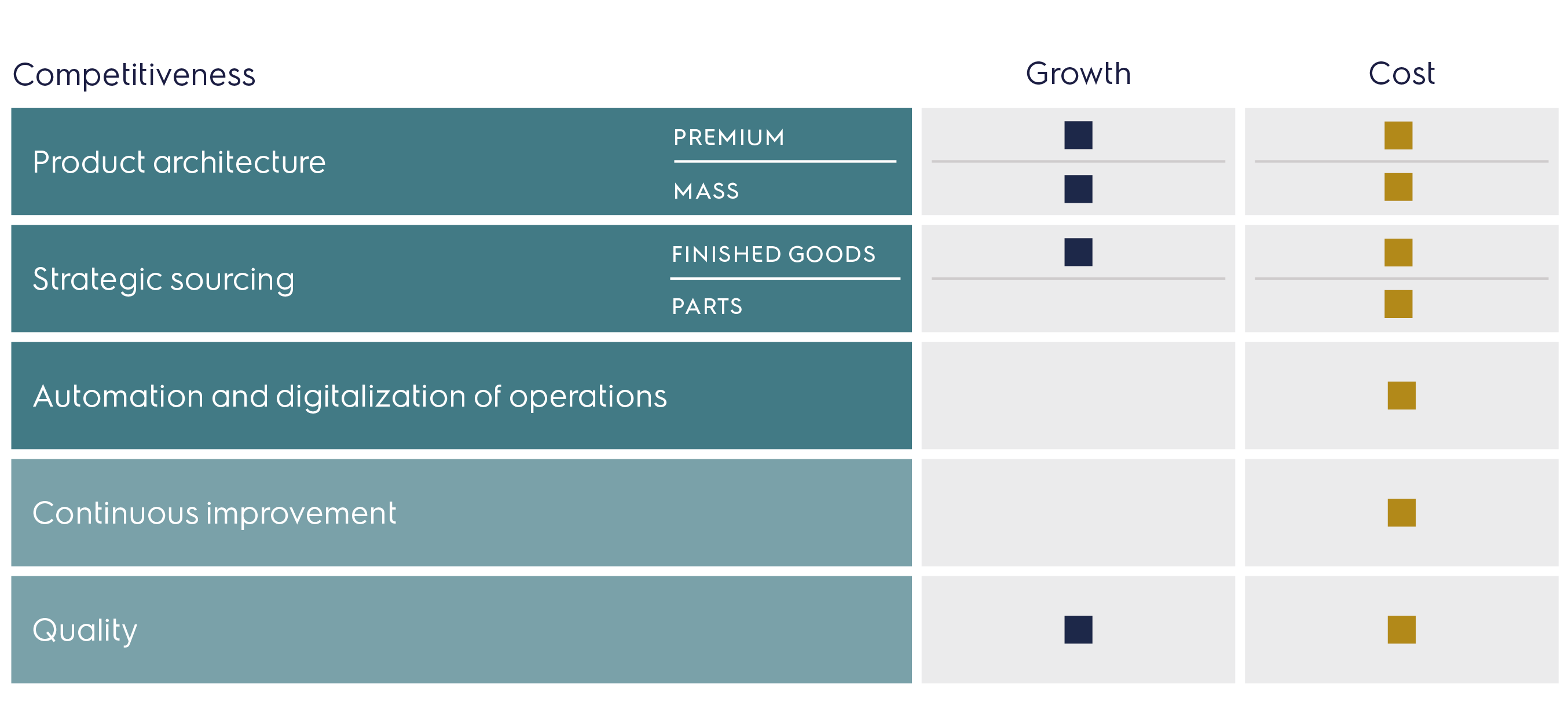
Execution to increase competitiveness
Operational Excellence
Electrolux is developing new modularized product architectures to drive targeted profitable growth and further improve efficiency and quality. Investments in automated and digital manufacturing setup enable competitive outstanding product offering across most markets.
Electrolux global product architecture and automation program is instrumental to drive consumer relevant product innovations as well as to increase productivity, flexibility and product speed to market. This allows the delivery of competitively priced, high quality products for both the mass and the premium segments. Investments in re-engineering programs, mainly in North America and Latin America, are expected to amount to a total of SEK 8 billion during 4-5 years, starting 2018. The investments will open growth opportunities through the manufacture of innovative products and provide strong cost improvements.
Efforts, to drive profitable growth and lower cost, focus on three main areas; Product architecture for consumer relevant innovations, Strategic sourcing and Automation and digitization of operations. These areas are supported by strong focus on continuous improvements and quality.

Product architecture
- Increased pace of consumer relevant innovations.
- Higher R&D agility and lower product cost.
- Improved flexibility and economies of scale.
Modularization increases the pace of innovation as it unlocks resources for investment in consumer relevant innovations. Modularization lowers product costs and the product development spend through standardized global modular platforms for new products. Global modular platforms facilitate the spread of successful launches from one market to another, with adaptations to local preferences. Such adaptations are crucial as consumer needs and preferences vary considerably between different parts of the world. Experience shows that modularization can reduce the time from product development to market for a new product by 20–30% and that the investment cost decreases by 15–20%.
Competitiveness is enhanced as new products are to a greater extent designed to allow a higher degree of automation and flexibility in their production. Importantly, modularization leads to increased flexibility by allowing customization of products using a limited number of standard components. Modular design also increases economies of scale in the sourcing of components. Through the re-engineering programs, the number of product architectures are expected to be reduced by more than 40% by 2022 vs 2016.
In 2018, modularization increased in the various product groups and led to increased efficiency in product development, marketing and production.
Strategic sourcing
- Single most important initiative to lower product cost.
- Global bundling of volumes and focusing on partnership with fewer suppliers.
Strategic sourcing entails a mix of several initiatives to further leverage the global scale. This includes further global bundling of volumes as more products are built on shared modules resulting in closer collaboration with fewer suppliers. Longer contracts enable these suppliers to invest in more efficient production set-up, creating a win-win situation in terms of shared lower costs. The global purchasing function coordinates and administers approximately 65% of all purchasing. Electrolux Responsible Sourcing program supports the worldwide effort in making the right decisions on suppliers and upholding the sustainability performance of the supply base.
Automation and digitalization of operations
- Strengthening cost competitiveness through improved efficiency.
- Quality gains.
- Digitalization optimizes manufacturing processes.
Production competitiveness is strengthened through increasing the level of automation, primarily resulting in efficiency improvements. An indication of the increasing level of automation is the number of robots. In 2020, it is estimated that more than 1,000 robots will be installed in Electrolux factories, compared to more than 700 in 2017. In 2018, comprehensive re-engineering programs were carried out at the refrigerator plants in Anderson, U.S., and Curitiba, Brazil, focusing on increasing automation. The Anderson plant will after the investment be in the forefront in the appliance industry and automation level will increase significantly from less than 10% to around 35%. The ongoing investment program in the Group is expected to increase capacity utilization by around 20% in 2022 vs 2016.
Products developed to be produced in automated factories need to be robust, and this is reflected in higher quality of the finished products. Quality is further boosted by the fact that quality control carried out by robots is fast and accurate as well as suitable in hazardous environments, thus reducing health and safety risks for employees. This will drive further improvement in quality, building on the strong performance in recent years. In 2018, product quality reached a new record level with a service call rate (SCR) of 3.3%. The Group has ambitious long-term goals to continue to improve quality and drives global quality efforts through the Committed to Quality program.
Sustainability is an important transformational driver to increase efficiency. Electrolux has a clear agenda to improve operational resource efficiency. The average energy consumption per unit produced in 2018 had been reduced by 44%, compared with 2005. The target for 2020 is a 50% reduction.
Digitalization of manufacturing increases efficiency and flexibility. Electrolux is building a digitally controlled and managed environment within factories that monitors operational information in real-time, including data from robots and machines but also from employees. The entire process flow in the factory is hence optimized resulting in a 5% potential productivity increase. The real-time data is available on a range of devices, including smartphones and tablets, allowing for fast reaction times. In 2018, the plants Kinston, U.S., and Sao Carlos, Brazil, were the pilots for digital manufacturing. Starting in 2019, the big data concept will be rolled out in all factories.
Digital processes for closer collaboration with Electrolux suppliers and retailers help reduce costs, improve quality and increase flexibility. As part of the digital transformation, Electrolux is building a digitally integrated value chain where sourcing, manufacturing processes and supply chain interact with the market to meet just in time demand of products.